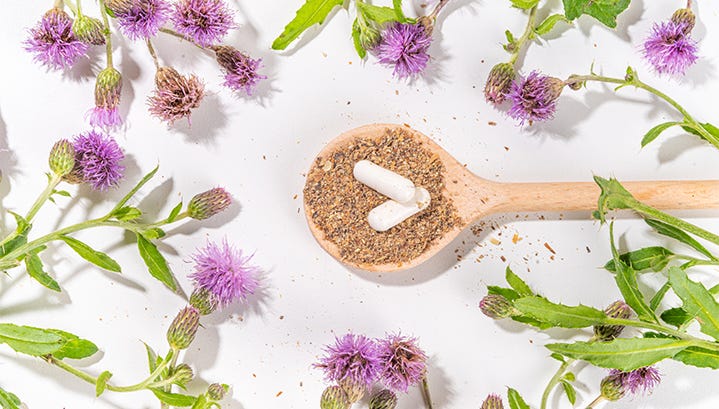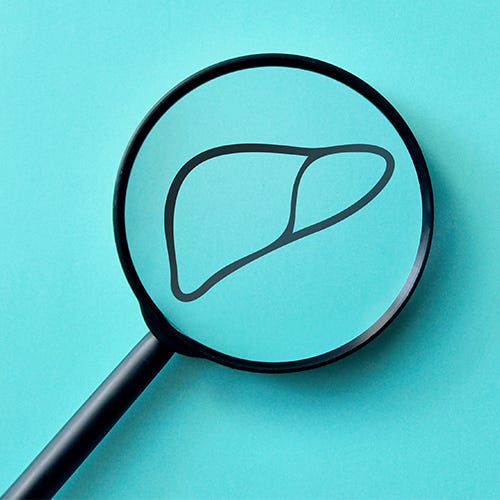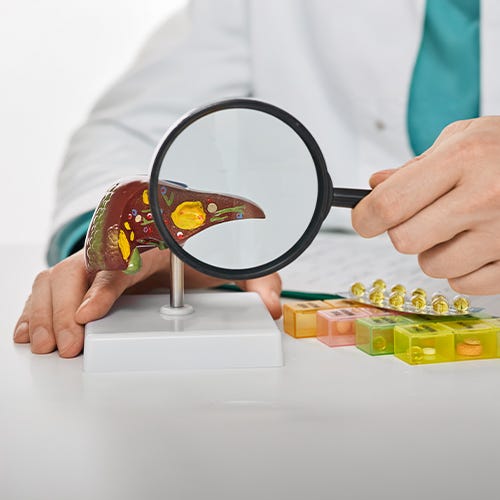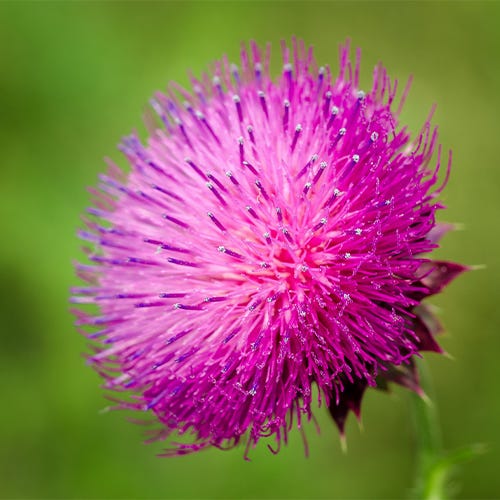Empty cart?
We can only assume that's because you haven't seen our latest offers
Sensilab uses cookies for their websites, which does not store personal data. Some cookies might already be installed. By proceeding to use this website you consent to the cookie usage.
Contact us online
100% satisfaction guarantee
Free delivery above €50
Contact us
info@sensilab.ieMilk thistle, a flowering herb native to the Mediterranean region, has gained widespread popularity as a potent health supplement. It mainly became popular due to its beneficial effects on the liver. However, there are many other promising uses and benefits to uncover.
This guide delves into why milk thistle is considered one of the most effective natural remedies for liver health, supported by traditional uses and scientific studies. We will also explore its other potential benefits and how modern science made breakthroughs to enhance its bioavailability.

Milk thistle (Silybum marianum) has a long history of use in traditional medicine, dating back over 2,000 years. Its therapeutic applications have been documented by various ancient civilisations, including the Greeks, Romans, and Egyptians. These historical uses provide a foundation for its modern reputation as a potent liver-supporting herb.
Ancient Greek and Roman medicine
The Greeks and Romans were among the first to recognise the medicinal value of milk thistle. The ancient Greek physician Dioscorides, in his seminal work “De Materia Medica,” described the use of milk thistle seeds to treat snake bites and various liver-related ailments.
The Romans, similarly, used milk thistle as a remedy for liver diseases, digestive problems, and gallbladder issues. Pliny the Elder, a Roman naturalist, also noted its use in his encyclopedic writings.
European herbal medicine
Throughout the Middle Ages, milk thistle remained a staple in European herbal medicine. It was commonly used to address liver and gallbladder disorders and jaundice and to promote bile production.
Herbalists of the time, such as Nicholas Culpeper, praised its ability to support the liver and treat conditions like hepatitis and cirrhosis. Milk thistle was also believed to protect against the harmful effects of alcohol and environmental toxins.
Traditional Chinese medicine
In traditional Chinese medicine (TCM), milk thistle was valued for its detoxifying properties. It was used to clear heat and remove toxins from the liver, support liver function, and improve overall health. TCM practitioners often combined milk thistle with other herbs to enhance its therapeutic effects.
Ayurvedic medicine
In Ayurvedic medicine, milk thistle was used to balance the body’s doshas (energetic forces) and improve liver health. It was often prescribed for liver-related conditions, including inflammation, enlargement, and congestion. The herb’s cooling and cleansing properties made it suitable for treating various pitta (heat-related) disorders.
Folk medicine
Across different cultures and folk traditions, milk thistle was utilised for a variety of ailments. In European folk medicine, it was used to treat skin conditions, such as eczema and psoriasis, due to its anti-inflammatory properties. It was also employed as a natural remedy for menstrual disorders and to support lactation in nursing mothers.
Modern traditional uses
Today, the traditional uses of milk thistle continue to influence its application in natural and holistic medicine. It is widely used to support liver detoxification, improve digestion, and promote overall health. The herb’s historical reputation as a liver tonic remains its most prominent attribute, backed by both anecdotal evidence and scientific research.

The traditional uses of milk thistle, particularly for liver health, have been extensively validated by modern scientific research. The active compound in milk thistle, known as silymarin, consists of a group of flavonoids, including silybin, isosilybin, silydianin, and silychristin. These compounds are primarily responsible for the herb’s therapeutic effects.
One of the most well-documented benefits of milk thistle is its liver-protecting properties. Silymarin has been shown to protect liver cells from damage caused by toxins, alcohol, and drugs. It does so by stabilising cell membranes, preventing the entry of toxins, and enhancing the regenerative capacity of liver cells.
Clinical studies and research
Numerous clinical studies have investigated the effects of milk thistle on the liver. These studies provide strong evidence for its efficacy in treating various liver conditions.
One of the unique properties of silymarin is its ability to promote liver regeneration. Research has shown that silymarin can stimulate the production of new liver cells, aiding in the repair and regeneration of damaged liver tissue.
A study published in Phytotherapy Research demonstrated that silymarin enhanced liver regeneration in rats after partial hepatectomy (surgical removal of part of the liver). This regenerative effect is crucial for patients with liver diseases where the liver’s ability to regenerate is impaired.
In addition to its antioxidant properties, silymarin has potent anti-inflammatory effects. It inhibits the production of inflammatory cytokines, which play a role in chronic liver diseases.
By reducing inflammation, milk thistle helps protect the liver from further damage and supports its healing process.
Silymarin has also been shown to modulate the immune system, enhancing the body’s ability to fight off infections and repair damaged tissues. This is especially beneficial in conditions like hepatitis, where the immune system plays a crucial role in disease progression and recovery.
Cancer research
Emerging research suggests that milk thistle may have potential anticancer properties. Laboratory studies have shown that silymarin can inhibit the growth of cancer cells and induce apoptosis (programmed cell death) in certain types of cancer, including prostate, breast, and skin cancer.
Silymarin’s anticancer effects are thought to result from its ability to induce cell cycle arrest, inhibit angiogenesis (formation of new blood vessels that feed tumours), and enhance the efficacy of chemotherapy drugs. While more research is needed, these findings highlight milk thistle’s potential as a complementary therapy in cancer treatment.

Milk thistle is generally well-tolerated, with a low incidence of side effects. Common side effects, if they occur, are mild and may include gastrointestinal disturbances such as nausea, diarrhoea, and bloating.
While most people choose to do a short milk thistle cure for the liver twice or three times per year, clinical studies have shown that milk thistle is safe for long-term use, even at high daily doses.
Dosage recommendations
Milk thistle is available in various forms, including capsules, tablets, tinctures, and teas. The most effective form is typically the standardised extract containing 70-80% silymarin.
For liver support, a common dosage is 200-400 mg of standardised milk thistle extract, taken two to three times daily. However, dosages can vary based on individual health conditions and should be determined in consultation with a healthcare provider.

One major issue with milk thistle for the liver is the low bioavailability of silymarin. This means that only a small fraction of the active ingredient is absorbed and utilised by the body, limiting its effectiveness.
To address this, scientists have developed the silybin-phosphatidylcholine complex, also known as phytosome technology.
This complex significantly enhances the absorption and bioavailability of silymarin, ensuring that a higher amount reaches the liver and exerts its beneficial effects.
In fact, milk thistle extract in phytosome form is 10 times more bioavailable and, thus, effective compared to the regular standardised extract.
In the hustle and bustle of modern life, keeping your liver healthy can be difficult. Natural milk thistle supplements, however, can offer a powerful means to aid liver detoxification and enhance liver function.
Performing a short liver cleanse twice annually helps maintain your liver’s peak condition, while a more lengthy liver detoxification program may be beneficial for those with abnormal liver readings. Explore our guide to understand the reasons and timing for doing a liver detox.
The Hepafar Liver Detox Bundle utilises the power of milk thistle extract in phytosome form, as well as other liver-supporting ingredients known to support and enhance its effects, such as dandelion, artichoke, ginger, burdock root, green tea, black pepper, and vitamins and minerals, like choline, selenium, zinc, and Vitamin E.
Milk thistle stands out as one of the most effective natural remedies for liver health. Its benefits extend beyond the liver, impacting the gallbladder, intestines, immune system, skin, bones, brain function, and more.
The enhanced bioavailability of silymarin through modern phytosome technology further amplifies its therapeutic potential, making milk thistle an indispensable component of liver health supplements like the Hepafar liver detoxification bundle.
References
Tedesco, D., et al. (2004). “Effects of silymarin, a natural hepatoprotector, in periparturient dairy cows.” Journal of Dairy Science, 87(7), 2239-2247.
Loguercio, C., & Festi, D. (2011). “Silybin and the liver: from basic research to clinical practice.” World Journal of Gastroenterology, 17(18), 2288-2301.
Pradhan, S. C., & Girish, C. (2006). “Hepatoprotective herbal drug, silymarin from experimental pharmacology to clinical medicine.” Indian Journal of Medical Research, 124(5), 491-504.
Federico, A., et al. (2017). “A new silybin-vitamin E-phospholipid complex improves insulin resistance and liver damage in patients with NAFLD.” Journal of Gastroenterology, 52(9), 955-962.
Products for you
Leaving already?
You’ve left [X] items in your cart.
We can’t guarantee the products will still be available when you return.
Check out now and get an EXTRA 10% OFF.
